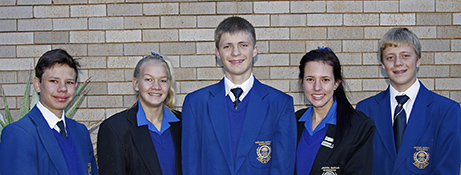UFS Department of Computer Science and Informatics motivates programming success among learners

From Sentraal High School are from the left: Albert Dreyer (full marks, Grade 9); Corlé van der Walt (full marks, Grade 10); Janco Venter (full marks, Grade 10); Soné du Pisanie (full marks, Grade 10) en Handré Venter (Grade 9). |
A group of learners from the Free State, who are taught at and by the University of the Free State’s Department of Computer Science and Informatics (under the Python project), came first in the Talent Search round of the South African Computer Olympiad (SACO).
According to Dr Anelize van Biljon, senior lecturer in the Department of Computer Science and Informatics, the Olympiad is presented in three main rounds: the Talent Search, the Application Olympiad, and the Programming Olympiad.
At the UFS’s Department of Computer Science and Informatics’ Python project, pupils from various schools in Bloemfontein attend programming classes where they are taught by staff and students of the department. These students are benefitted by the opportunity to transfer their knowledge to others. All the classes are free of charge.
Anelize explains: “The name was chosen because we use the Python programming language. It is a language with considerable appeal – not one of the fastest – which can be learnt relatively quickly, and which conforms to SACO requirements. The purpose of this programming is to implement algorithms (the learner is given a problem, makes a plan to solve it, and does the necessary programming). Thus, it is not about the looks of the programme, but about its effectiveness and speed.”
Anelize is the initialiser and co-ordinator of the Python project. "I started this project in 2010 in the Department of Computer Science and Informatics for learners from Grades 6 to 12 to encourage them to take the subject. These classes exposed them to something more than school work. I enjoy this kind of competitions and am also very involved with Maths Olympiads.
Achievements such as these are good advertisements for the Department of Computer Science and Informatics,” she said.